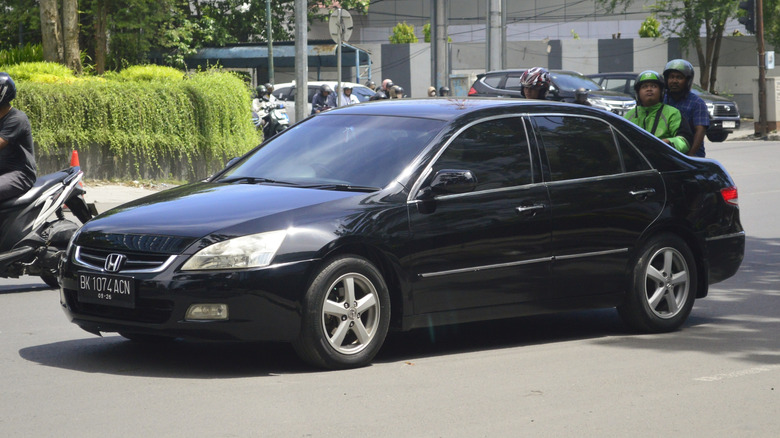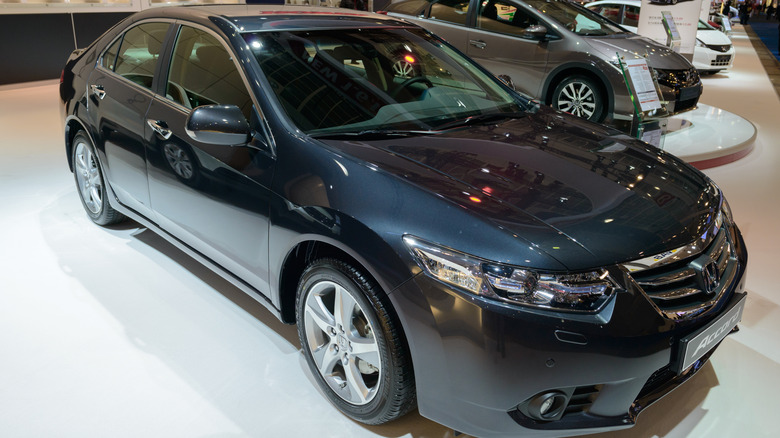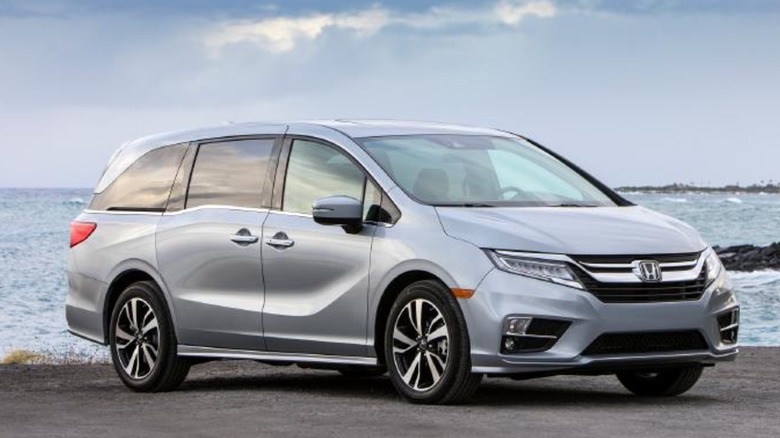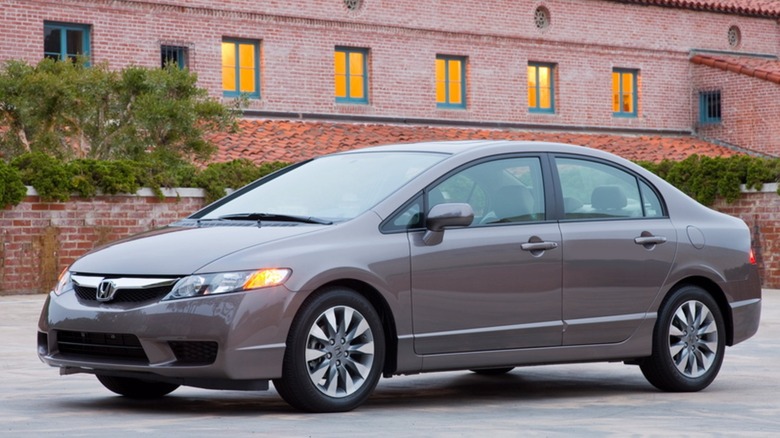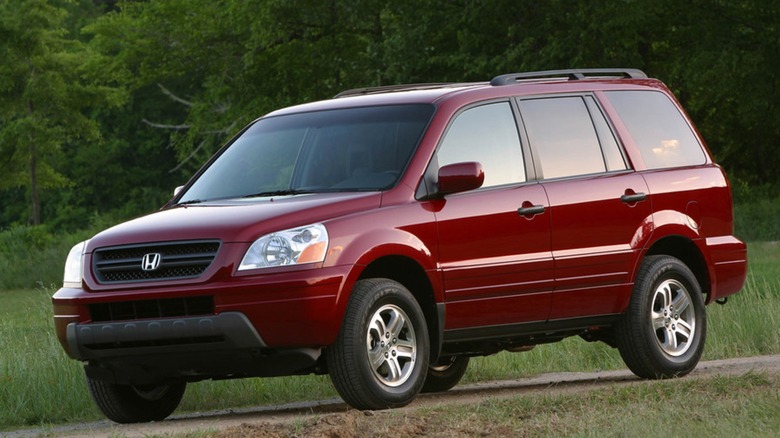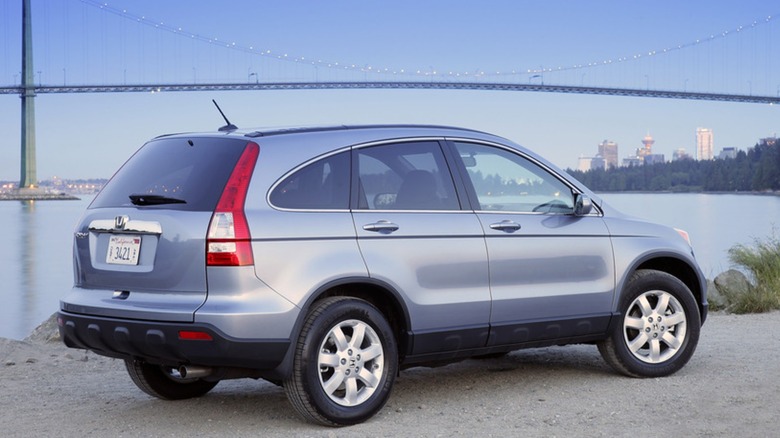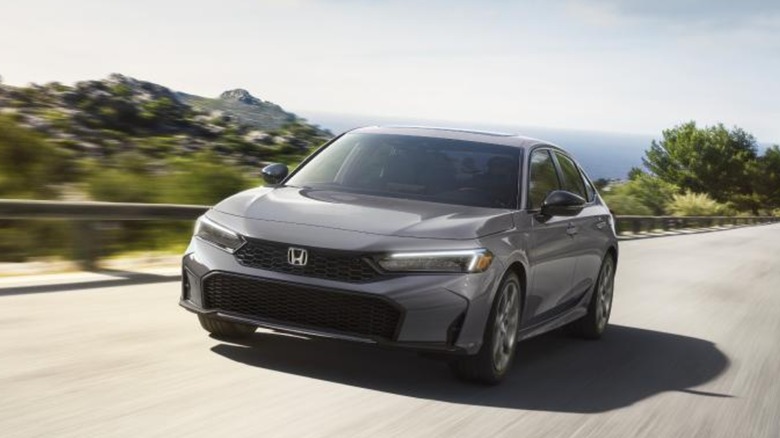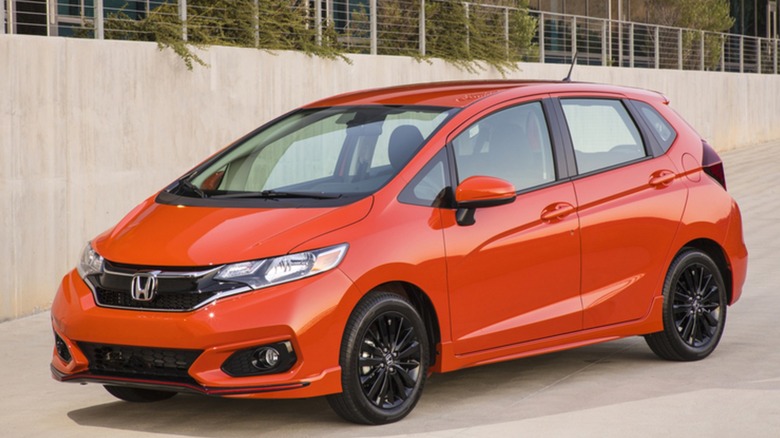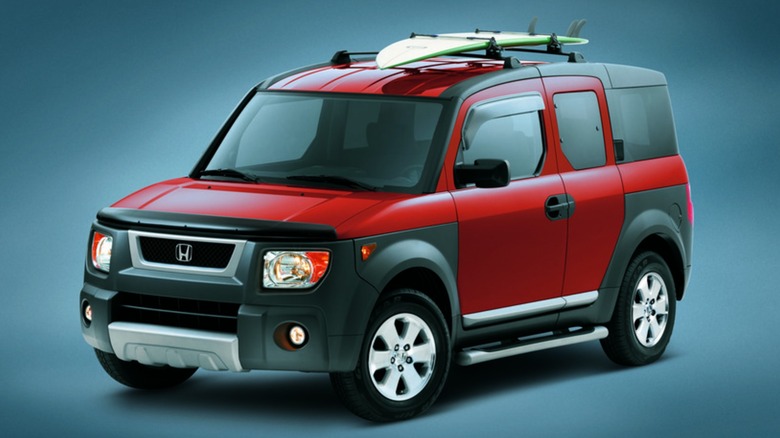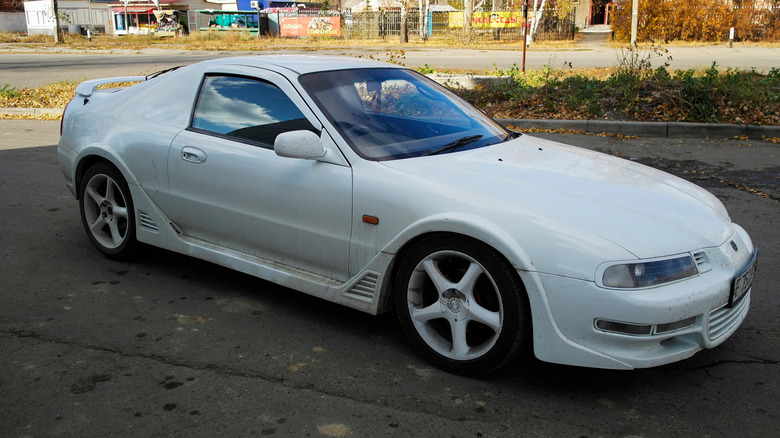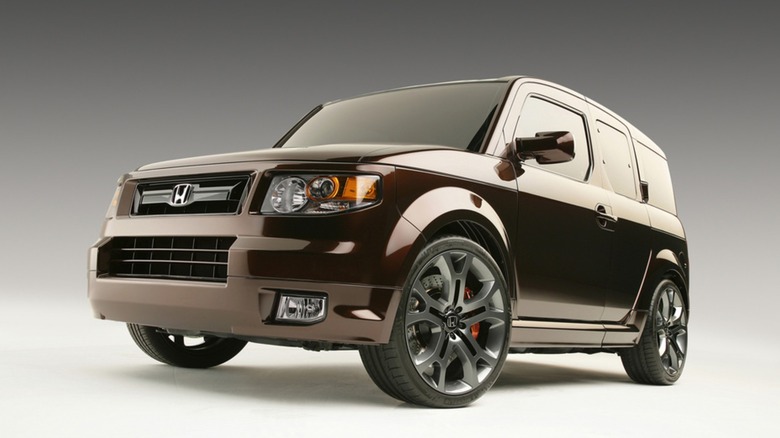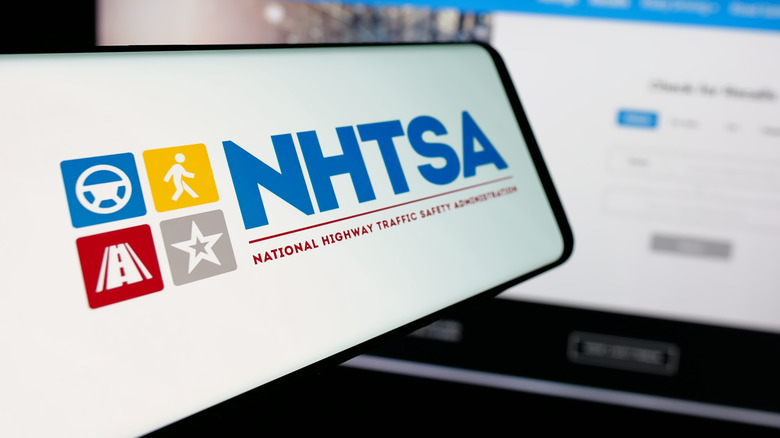13 Honda Recalls That Impacted Millions
Although Honda isn't the biggest car manufacturer in the world, it's still pretty high up there. The company has been around since the 1940s and continues to push boundaries with its many vehicles on offer. But even though you have plenty of options when looking at every Honda model available in 2025, some buyers will want to save time and money with a used car instead. This isn't always a bad choice, but a poorly-managed ride isn't the only thing you'll need to be wary of.
Throughout the years, Honda has been forced to deal with a wide number of recalls. Some of these aren't so impactful, simply dealing with incorrect manuals, but others could lead to increased risk of vehicular damage or personal injury. Worse yet, many of these recalls ended up impacting millions of cars at once, which also makes it possible that some still-affected owners might not be aware of the issues. There have been at least 13 notable Honda recalls that have impacted millions, and each one poses a significant danger to anyone inside the affected vehicles.
Ignition switch engine stalling
One of the earlier recalls that impacted many Honda owners occurred in 2002, in which electrical contacts were found to wear down in ignition switches. This issue was present in the 1997-1999 Accord, CR-V, Odyssey, Prelude, and Civic. While the NHTSA estimates around 1 million vehicles to have been affected, Honda's own report estimates that close to 1.3 million cars were potentially involved. It also notes that the problem shouldn't affect most owners, mentioning that it is only present in less than 1% of the relevant models.
No accidents caused by the ignition switch malfunction were reported at the time of the recall. However, similar recalls would happen in the future, with 2003 Accords and Civics suffering from their own ignition switch problems. The actual issue was different in this case, but it would resurface again in future years, which was far from a great example of the company's due diligence. While the electrical contact degradation might not be anything to worry about these days, it's a prime example of why a car like the 1998 Accord is one of many used Honda models you should steer clear of at all costs.
Gear failure
In 2004, one recall that affected many vehicles had to do with the automatic transmission in some Honda SUVs and minivans. The vehicles' internals would get so hot that the gears inside the transmission could chip or break, leading to the engine locking up. Although this primarily covered the 2002-2004 Odyssey and 2003-2004 Pilot, 2003-2004 Accord owners were also at risk. Acura models were also affected, which makes sense when you consider how Acura is Honda's luxury division.
Honda's report of this issue came in two waves, first covering 600,000 light truck models and then covering nearly 500,000 passenger-sized rides. This lines up with the NHTSA's estimated number of nearly 1.1 million affected vehicles. The recall itself makes mention of a 15,000-mile cutoff, which is when dealers will inspect the gears for signs of discoloration. If you're buying one of these older Honda models, it might not be a bad idea to get as much information on the transmission as possible.
Battery sensor problems
The 2017 battery sensor recall didn't have much to do with worn-down parts or improper mechanical design. Instead, it had to do with the casing for 2013-2016 Accord batteries, which wasn't properly sealed against water. This notably doesn't affect any other Honda model, but it still impacted around 1.15 million cars. Additionally, there were reports of at least four fires due to this flaw, making it one example of a recall that wasn't able to fully prevent the issue's potential damages.
Ironically, Honda had the 2013 Accord to thank for a boost in sales. The affected model year had, in fact, sold significantly more than the 2 years prior. Afterward, only 2017's figures come within a few thousand sales. The popularity of the Accord is likely why this issue was noticed in the first place, even in spite of the weather conditions needed for it to occur. With such a focused yet all-encompassing flaw, it's not surprising to see this recall being one of the earliest to affect these models.
Rearview camera issues
Although rearview camera issues might not be as devastating as problems that can cause fires or physical engine damage, they can still be quite dangerous to the concept of convenience. A 2023 recall was issued after an issue in which the cameras in certain Honda models would fail to display, due to a poor internal cable connection. This recall affected Odyssey, Passport, and Pilot models from 2018 to 2023, encompassing over 1.2 million vehicles in total. Interestingly, this wasn't even the first time these three models had notable issues.
Honda announced recalls for the Odyssey, Passport, and Pilot in 2020 due to various other issues. These issues included malfunctioning software, sliding door problems, and even other rearview camera concerns that would distort the image instead of simply not displaying anything. However, these issues only affected around 600,000 vehicles. Again, although it's not nearly as problematic as what came before, this rearview camera recall ultimately affected a much wider number of people.
2018 air bag ruptures
Takata's airbags have earned a place as part of the deadliest car recalls in history, and Honda has fallen victim to them just like many other manufacturers. These airbags have been known to rupture, launching shrapnel into the occupants of a vehicle. Many different recalls have been made for these airbags over the years, and counting every single one for Honda wouldn't leave much room for other notable flaws. However, there are a few years in particular when the NHTSA sent out millions of cars to be recalled for replacement airbags at once.
In 2018, over 1.35 million Honda vehicles were recalled due to this issue. It covered vehicles with model years from 2010 to 2015, including the Civic, Accord, CR-V, and Insight. This is far from the only recall covering rupturing airbags, so you shouldn't expect this issue to only actually affect a small percentage of each model. This isn't even the latest year to deal with recalling them, showcasing just how prevalent — and how dangerous — this problem ended up becoming.
Low beam headlight problems
Although this recall was issued in 2012, it actually only covers vehicles from the early 2000s. The 2002-2003 Civic, 2002-2004 CR-V, and 2003-2004 Pilot all faced an issue in which the low beam headlights could become inoperable due to electrical terminals melting onto the wiring harness connector. It took a long time for this issue to be discovered, and it affected over 1.37 million vehicles. If you're considering buying one of the older models mentioned in the recall, unless you know that previous owners have already repaired it, you can expect those headlights to fail at any time.
The Honda Element also suffered from issues with low-beam headlights, but it didn't join others in the recall. This was attributed to its relatively low failure rate, with 17 out of over 300,000 vehicles being reported to have issues. Since further headlight recalls haven't mentioned the Element at all, its older models are probably a much safer bet if you want to avoid this issue entirely. Be aware that other, more serious problems may also require your attention.
Automatic transmission issues
Another recall regarding automatic transmissions happened in 2011, leading to similar issues that stemmed from the gear failures reported in 2004. Internal bearings could become damaged in the affected vehicles, including 2005-2010 Accords, 2007-2010 CR-Vs, and 2005-2008 Elements, causing short circuits and unexpected rolling when parked. Over 1.5 million vehicles had the potential to fall victim to this, and if you include numbers from overseas, Honda recalled around 2.5 million cars over this auto bearing bust-up. Once again, Honda reported a lack of injuries or deaths resulting from the problem.
Although it was a widespread issue, the existence of this recall might not matter much to the average driver. It could be triggered by quickly switching the vehicle between reverse, neutral, and drive, which is an unlikely scenario for anyone not fighting over weather conditions or rough terrain. On the other hand, those who most need their transmission to be reliable are the ones who will likely wear it out more quickly. And the average driver could always end up in an emergency situation requiring this scenario, making the recall quite relevant for every affected model.
Steering difficulties
This recall is actually the most recent one to affect more than a million Honda drivers. In 2024, close to 1.7 million vehicles were noted to contain defective parts in their steering gearboxes. That number happens to include the recent 2025 releases of the Civic, CR-V, and HR-V, as well as the Acura Integra. These are models that can still easily be found in brand-new condition, so you won't have to worry as much about this problem if you aren't going with secondhand options.
So far, this is the latest recall to affect the modern HR-V. The Civic and CR-V both suffered from a later recall regarding fuel pump cracks, but this only covered a little over 700,000 models total. Seeing as how our 2025 Honda Civic Si review gave it a perfect 10/10 score, it goes to show how even modern-day, seemingly perfect cars can end up with some pretty devastating problems.
Fuel pump failure
Recent fuel pump issues may be concerning to many Honda owners, but the end of 2023 featured an even more severe recall stemming from failures. Nearly 2.5 million vehicles across 100 different models ended up in this recall, covering releases as early as 2013 and as late as 2023. The Accord, Fit, HR-V, and even some hybrid models, such as the Clarity and CR-V, were affected. The luxury lineup wasn't immune to this problem either, with models from Acura, such as the MDX and TLX, being included.
Interestingly, some model years altogether avoided the issue. The 2021 Insight is not part of the recall. However, its 2020 and 2022 model years are. The HR-V also has a sizeable gap between 2020 and 2023, allowing for quite a few safe model years on the used market. The Accord and Odyssey aren't nearly as lucky, with the recall spanning across an entire decade, forcing you to keep an eye out in case they weren't properly maintained.
2019 air bag ruptures
In case the 2018 recall wasn't bad enough, 2019 had two additional recalls that focused on Takata's rupturing airbags. Together, these affected over 2.7 million Honda vehicles released between 2001 and 2014. If you include Acura in the mix, that range increases to 2016 thanks to the ILX. The second of these 2019 recalls expanded on how many Honda Fit models would need to be examined, too, adding the 2008 model year to the already problematic 2007 release.
Only by 2020 would Honda see the last of these rupturing airbag recalls. Those ended up being very impactful as well, affecting over 2.3 million vehicles, coming close to the numbers reported in 2019. After this, no further Takata airbag recalls would appear on Honda's radar, although Honda issued a Do Not Drive warning in 2023 for some of the older models . The most recent equivalent event was unintentional airbag deployments in 2024. While that could still lead to injury, it's also a much less dramatic flaw than an explosion of shrapnel.
Seat belt buckle breakage
In 1995, Honda issued its biggest recall that didn't have anything to do with airbags. The problem instead stemmed from breaking seat belt buckles, which could make it impossible to fasten yourself in for a safe drive. This one problem ended up affecting 3.7 million vehicles at once, including the 1986-1991 model years of the Accord, Civic, and Prelude. Coincidentally, these failing belt buckles were also made by Takata, with this recall coming around 20 years before the company's infamous rupturing airbags scandal.
This is Honda's oldest recall affecting over 1 million cars. Technically, another massive recall occurred in 1977, which involved a faulty fuel filler cap latch that could end up leaking gasoline. This affected nearly 1.4 million vehicles, but every one of them was a model of motorcycle rather than Honda's usual sedans, SUVs, or minivans. It's still a very notable recall, but it doesn't fit in quite as well with the rest of Honda's woes, especially when looking at how many more vehicles ended up affected by future issues.
2016 air bag ruptures
Something unique happened in 2016 regarding the Takata airbag rupturing issues. During that year, Honda issued multiple recalls covering the same issue, and each one covered over 1 million vehicles. When combining them all, that number is closer to 6.74 million, surpassing nearly everything that came after. Across each recall, vehicles built between 2003 and 2016 were included, with a majority of them coming from the 2010 and 2011 model years.
The year 2016 was the only year in which Honda suffered from three separate recalls affecting over a million drivers each. They all cover the same issue, but it shows how complicated such a widespread problem can be beyond a first glance. The year was also when Honda drivers experienced several deaths from Takata airbags. With this in mind, it's really no wonder that each of those recalls would be trying to reach millions of drivers.
2015 air bag ruptures
The end of 2014 might have been when Honda began its Takata airbag recalls, but 2015 was when it reached unfathomable heights. This was the year of Honda's biggest recall in history, covering nearly 6.3 million vehicles on its own. It was later joined by another recall, expanding that number by around 3.5 million, which brings the total to almost 10 million. By these metrics, there's simply no other year that has been as devastating for Honda.
These recalls affected model years between 2001 and 2007, as well as later Element models up to 2011. The 2001 Civic is mentioned in both, which is especially noteworthy when you consider its status as one of the Hondas with the most recalls to date. Unfortunately, since it took so long for this deadly issue to be discovered, not all defective airbags have been replaced. One of the most recent injuries or deaths associated with these airbags dates back to 2023, which could mean that multiple models subject to this recall are still not safe today.
Methodology
This article primarily focuses on individual NHTSA recalls that affected at least 1 million vehicles. There were multiple smaller recalls relating to airbag ruptures over the years, and they could very well add up to an extra million on their own. But as you can see for yourself, you wouldn't have much room to cover other major issues if you started including every individual recall of Takata's airbags. This is also why they earn more than one spot on this list, with the massive number of affected vehicles warranting some extra attention.
Recalls were also chosen based on the number of cars that actually needed to be recalled. A 2006 recall was issued for nearly 1.2 million Honda vehicles, but this only covered incorrect text in the owner's manual. Drivers didn't even need to take their vehicle in to get the problem fixed; They just needed to wait for a postcard that had the right information. It might technically be listed as a recall, but it's up to you to decide whether it truly classifies as one.


